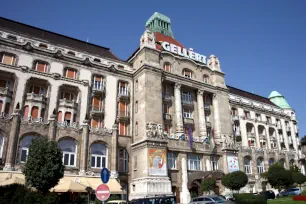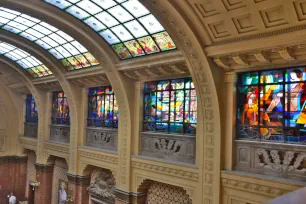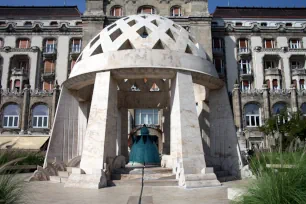At the foot of the Gellért Hill stands the famous Gellért Hotel, which shares its premises with the magnificent Gellért Thermal Baths. The hotel opened in 1918 as the first luxury hotel in Budapest.
History




The hotel and bath complex was built at the site of a thermal spring that was discovered in ancient times. The curative properties of this spring were already well-known by the Romans. The first reference to a permanent thermal bathhouse dates from the time of King Andrew II, who reigned over Hungary during the early thirteenth century. The bathhouse was expanded during the occupation by the Ottomans. In 1894, it was demolished to make way for the Freedom Bridge.
Construction of the current edifice started in 1912. It opened six years later, at the end of World War I. The baths were expanded in 1927, when a wave bath was built, and again in 1934, when its whirlpool opened. In 1945, during the siege of Budapest at the end of the Second World War, the Gellért Hotel suffered significant damage. Shortly after the war, it was restored and modernized. It was renovated in 1961 in an attempt to recreate its pre-war splendor. More recently, the hotel was completely refurbished in 2008.
The Hotel
Soon after its opening, Hotel Gellért gained prominence as the first luxury hotel in Budapest. It boasted some of Europe’s most splendid and modern thermal bathing facilities. Its fame spread across Europe, and even today it is one of the most famous hotels on the continent.
The hotel was built in a modernist Secession style, a local variant of Art Nouveau. It was designed by three Hungarian architects: Ármin Hegedűs, Artúr Sebestyén and Izidor Sterk.
The building has monumental facades, with imposing domed entrances. The main facade, facing the river, is dominated by a pyramidal dome. The facade facing Gellért Hill features a Byzantine-style dome and a massive arched portico decorated with sculpted reliefs created by Aladár Gárdos.


The interior of the hotel is magnificent. The main hall has a large vaulted skylight and is decorated with large Corinthian columns and niches containing statues. Right below the skylight is a series of colorful stained-glass windows.
From the hall, you can peek inside the central swimming pool, also covered with a vaulted skylight. Columns around the swimming pool are beautifully embellished with carved reliefs. The glass vault is often opened, depending on the weather.
In the stairwell at the end of the lobby is a magnificent stained-glass window created in 1993 after a design by Bozó Sztanisits. The backlit window depicts the Tale of the Miraculous Hind, a poem by János Arany that is based on an old Hungarian legend.
The Baths
The baths are even more lavishly decorated, with colorful majolica tiles, marble sculpted pillars and sensual female statues. There are baths for men and women, each with several pools of different temperature. The entrance to the baths is on Kelenhegyi út opposite Gellért Hill. Hotel guests have free access and can take an elevator that brings them directly to the baths. There’s also a jacuzzi, steam room, sauna and a medicinal section.

The hotel also has a large, thirty-eight meters long (125 ft) outdoor swimming pool with a wave mechanism, as well as an outdoor thermal bath. They are set in a stylish terraced garden embellished with numerous statues, mascarons and a cascade.
Gellért Fountain
In front of the Gellért Hotel stands a domed fountain, built in 2003 by the Hungarian architect Sándor Dévényi. The fountain symbolizes the city’s thermal springs.
- Next: Cave Church
- More Sights & Attractions in Budapest

